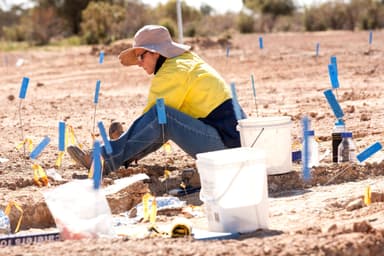9 Days
6 Peoples
Easy to Moderate
Offered in partnership with the Eromanga Natural History Museum (ENHM), this Australian Geographic Travel expedition will take you deep into the outback of Queensland, where you’ll join a paleontology dig experience like no other. In the remote southwest town of Eulo, some ten species of extinct megafauna have been found. These animals lived around 150,000-50,000 years ago and included the world’s largest marsupial—the giant bear-shaped Diprotodon. And as with any paleontology excavation, there is always the possibility of finding new species!
Please note: The tour starts in Eulo and finishes after breakfast on day 9. If you don't plan to self-drive but arrive and depart by plane, please contact us to arrange transfers and a post-night for you. Recommended arrival flight on day 1: into Cunnamulla. Recommended Departure Flight Day 10: from Quilpie.

The Eromanga Natural History Museum (ENHM) conducts this paleontology dig and this year marks the second time it is offered as part of an itinerary with Australian Geographic Travel. The deposits of megafauna from Eulo represent some of the most concentrated megafauna bone deposits found in open sites in Australia. By collecting associated skeletons of these megafauna, you will be helping researchers build up a picture of what their prehistoric biology might have been, looking at differences in individuals, sexes and size. Your work on this project is essential to our understanding of Australia's top Pleistocene herbivore. The dig itself takes place over the course of five days. There, you will be working alongside the site researchers and your guide who will instruct you on the proper fossil excavation and collection techniques. You will also be joining the team in the fossil preparation lab in Eromanga where you will learn how to clean and repair fossils once they have been excavated. The fossils you excavate and prepare have a very real chance of being on display in future exhibits in the Eromanga Natural History Museum.
Day 1
Arrival Day
Make your own way to Eulo in preparation for dig starting tomorrow. (If transfers from Cunnamulla Airport or anywhere else are required, please ask us and we can book this for you).
Day 2
Digging & Excavation Day 1
Day 3
Digging & Excavation Day 2
Day 4
Digging & Excavation Day 3 & Yowah Opal Fields
Day 5
Digging & Excavation Day 4 & Protection of Fossils
Day 6
Digging & Excavation Day 5 - Jacketing of Fossils
Day 7
Explore Eromanga Natural History Museum
Day 8
Hands-On fossil work at Eromanga Natural History Museum
Day 9
Tour finishes